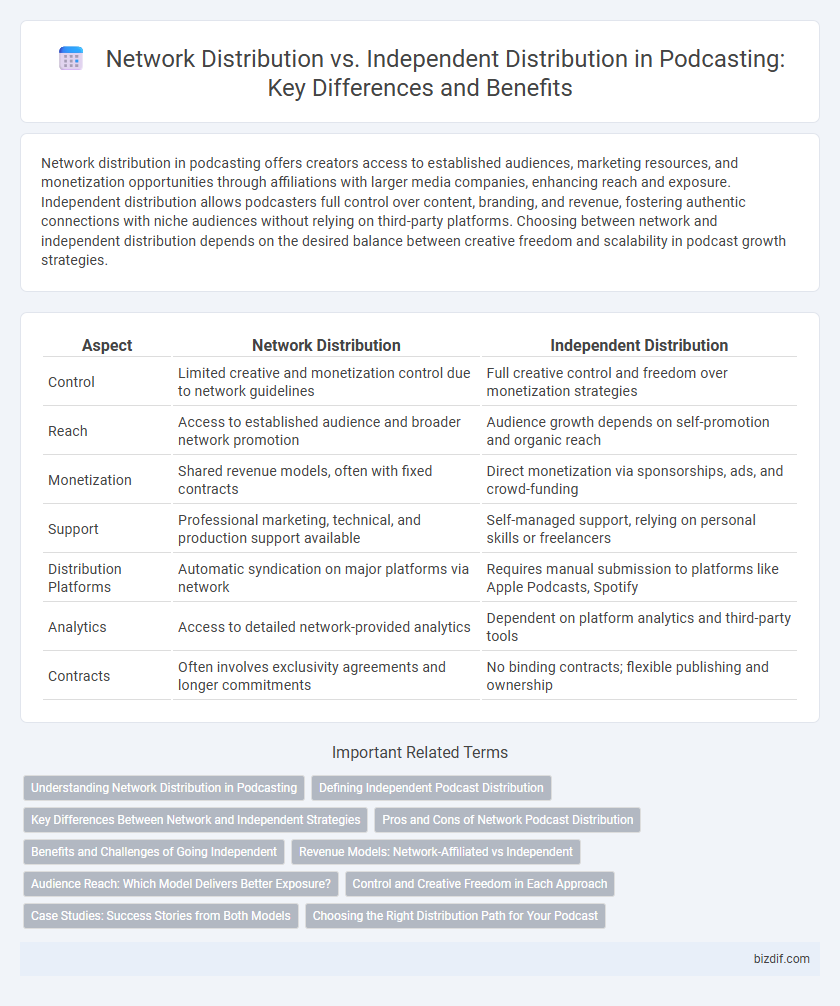Network distribution in podcasting offers creators access to established audiences, marketing resources, and monetization opportunities through affiliations with larger media companies, enhancing reach and exposure. Independent distribution allows podcasters full control over content, branding, and revenue, fostering authentic connections with niche audiences without relying on third-party platforms. Choosing between network and independent distribution depends on the desired balance between creative freedom and scalability in podcast growth strategies.
Table of Comparison
| Aspect | Network Distribution | Independent Distribution |
|---|---|---|
| Control | Limited creative and monetization control due to network guidelines | Full creative control and freedom over monetization strategies |
| Reach | Access to established audience and broader network promotion | Audience growth depends on self-promotion and organic reach |
| Monetization | Shared revenue models, often with fixed contracts | Direct monetization via sponsorships, ads, and crowd-funding |
| Support | Professional marketing, technical, and production support available | Self-managed support, relying on personal skills or freelancers |
| Distribution Platforms | Automatic syndication on major platforms via network | Requires manual submission to platforms like Apple Podcasts, Spotify |
| Analytics | Access to detailed network-provided analytics | Dependent on platform analytics and third-party tools |
| Contracts | Often involves exclusivity agreements and longer commitments | No binding contracts; flexible publishing and ownership |
Understanding Network Distribution in Podcasting
Network distribution in podcasting leverages established platforms and industry connections to maximize audience reach and streamline monetization through advertising partnerships. Podcasters benefit from professional marketing, dedicated technical support, and broader syndication opportunities, enhancing visibility across multiple listening apps and devices. This structured approach contrasts with independent distribution, which offers full creative control but demands greater effort in audience building and revenue management.
Defining Independent Podcast Distribution
Independent podcast distribution refers to podcasters publishing and distributing their content without relying on major podcast networks or aggregators, maintaining full control over their episodes, monetization, and listener data. This approach enables creators to directly host their podcast feeds on platforms like Libsyn, Anchor, or Podbean, ensuring greater flexibility in content management and revenue streams. Independent distribution often results in a more personalized connection with the audience, as podcasters can tailor marketing strategies and engagement without network-imposed restrictions.
Key Differences Between Network and Independent Strategies
Network distribution offers podcasters access to larger, established audiences and professional marketing resources, enhancing overall reach and monetization potential. Independent distribution provides creative control and flexibility in content, allowing podcasters to build niche communities and retain full ownership of their intellectual property. Key differences lie in scalability, revenue models, and control over content dissemination and brand management.
Pros and Cons of Network Podcast Distribution
Network podcast distribution offers extensive reach and access to established advertising partnerships, providing creators with reliable monetization opportunities and professional marketing support. However, it often requires creators to relinquish a degree of creative control and share significant revenue percentages with the network. This model benefits podcasts seeking rapid audience growth and brand exposure but may limit flexibility compared to independent distribution.
Benefits and Challenges of Going Independent
Independent distribution in podcasting offers creators full control over content, monetization strategies, and audience engagement, fostering a direct relationship with listeners. Challenges include handling technical aspects, marketing efforts, and securing sponsorships without the established infrastructure and brand power of a network distribution. This approach suits podcasters aiming for creative freedom and long-term revenue potential, despite the increased workload and need for strategic promotion.
Revenue Models: Network-Affiliated vs Independent
Network-affiliated podcasts typically benefit from established advertising partnerships and revenue-sharing agreements, providing more consistent income through sponsorship deals and dynamic ad insertion. Independent podcasts primarily rely on direct monetization strategies such as listener donations, crowdfunding, merchandise sales, and exclusive content subscriptions via platforms like Patreon. Both models present distinct revenue potentials, with networks offering scalability and brand support while independents maintain full control over revenue streams and audience engagement.
Audience Reach: Which Model Delivers Better Exposure?
Network distribution offers podcasters access to established platforms with built-in audiences, significantly amplifying exposure through collective marketing and cross-promotion among shows. Independent distribution relies on organic growth, leveraging social media, SEO, and niche communities to build a loyal listener base but may face slower audience acquisition. Analyzing metrics like download rates, listener demographics, and engagement levels reveals that network distribution generally delivers broader initial reach, while independent models foster deeper, more targeted connections over time.
Control and Creative Freedom in Each Approach
Network distribution in podcasting offers streamlined access to a broad audience but often requires creators to adhere to network guidelines, limiting control and creative freedom. Independent distribution empowers podcasters with full ownership of content decisions and publishing schedules, fostering unique creative expression without external constraints. Balancing audience reach and artistic control depends on the podcaster's priorities for growth versus autonomy.
Case Studies: Success Stories from Both Models
Case studies reveal that network distribution, exemplified by podcasts like "Serial," leverages established platforms for wide reach and monetization, resulting in rapid audience growth and brand partnerships. Independent distribution, as seen with podcasts like "The Moth," offers creators full control over content and revenue streams, fostering authentic engagement and niche audience loyalty. Both models demonstrate success through tailored strategies that maximize audience connection and financial sustainability.
Choosing the Right Distribution Path for Your Podcast
Network distribution offers podcasters access to established audiences and marketing resources, facilitating faster growth and monetization opportunities. Independent distribution provides full creative control and ownership of content, allowing for flexible branding and direct listener engagement. Evaluating your goals for reach, revenue, and autonomy helps determine the ideal distribution path for your podcast's success.
Network distribution vs Independent distribution Infographic

 bizdif.com
bizdif.com